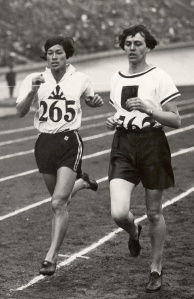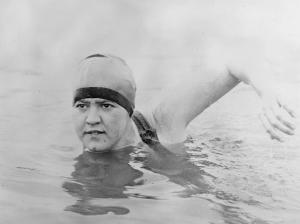Colleen English
Pennsylvania State University @ Berks
In the IAAF World Championships, the Olympic Games, and a host of other international, national, and local track and field meets, women compete in a wide variety of events, including middle- and long-distance races, like the 1500-meter, 10,000-meter, and the marathon. However, the inclusion of women in these races has a long history of exclusion. Many people already know the story of women’s fight for acceptance into the marathon—from Bobbi Gibb unofficially racing, wearing a swimsuit and nurse’s shoes, to Kathrine Switzer registering in 1967 using only her initials, to the USA’s Joan Benoit capturing the Olympic gold medal in 1984. These fights for entrance into the marathon represent key moments in women’s attempts at equality in sport. However, earlier struggles for inclusion must also be included in the history of women’s struggles for participation.
One such event, the women’s 800-meter race in the 1928 Olympics in Amsterdam—the first ever time women competed in Olympic track and field—led to the exclusion of women from the race (and any Olympic competition longer than 200 meters) for the next 32 years. Part of the reason for the controversy surrounding this 800-meter race stemmed from the perception that nearly all the women collapsed upon finishing the race. In this post, I will explore why one short race led to decades of women’s exclusion.

The fateful race began on August 2, 1928, with nine women at the starting line. Each of the nine women finished the race with six runners breaking the previous world record. Lina Radke of Germany won the gold medal, completing the race in 2 minutes, 16 and 4/5 seconds, fully seven seconds faster than the previous world record, which Radke also held.[1] Hitomi Kinue of Japan placed second followed by Sweden’s K. Gentzel in third. Other world record breakers included Canada’s Jean Thompson and Fanny Rosenfeld, finishing fourth and fifth respectively, and American runner Florence MacDonald who finished sixth.
The media, at least in part, were responsible for stirring up controversy surrounding the race. Many newspapers reported the event as a disaster. Sportswriter William Shirer detailed in the Chicago Tribune that five women collapsed after the race and that Bostonian and fifth-place-finisher Florence MacDonald needed to be “worked over” after “falling onto the grass unconscious” at the end of the race. His story also included details that silver medalist Hitomi of Japan required a fifteen-minute revival period after suffering from complete exhaustion after nearly beating Radke in the final seconds of the race.[2] In the Pittsburgh Press, Notre Dame football coach and in Amsterdam, reporter for a press syndicate, Knute Rockne claimed that only six women finished the race and that five of these women collapsed. He stated, “It was not a very edifying spectacle to see a group of fine girls running themselves into a state of exhaustion.”[3] New York Times correspondent Wythe Williams reported the event similarly. He claimed that six of the women “fell headlong on the ground.”[4]

In Great Britain and Canada, the press shared similar attitudes toward the race as those in the United States. In London, The Times called the 800-meter race for women “dangerous.”[5] The London Daily Mail also decried the race, highlighting the exhaustion of the competitors and claiming that the race was too difficult for women. Even Lou Marsh’s balanced reaction to the race in the Toronto Star, where he lamented that Canadian Jean Thompson didn’t win, mentions that Thompson and her teammate, Rosenfeld, collapsed at the finish.[6] The Montreal Daily Star took Marsh’s criticisms a step further, calling the race a “disgrace” and recommending that it “should be taken off any future program” because “it is obviously beyond women’s powers of endurance, and can only be injurious to them.”[7]
The fact that Germany’s Radke won the race in world record breaking time, as did the other five top finishers, did not play a role in the media’s diagnosis of the problem. These performances, which outmatched all previous records, couldn’t, at least for the media, explain the understandable exhaustion after running the half mile. According to the press, the only viable reason for world-record breaking women to exhibit visible exhaustion was innate female frailty. Surely it couldn’t have been the fact that they had run faster than any before them. All these competitors had shown, at least in the eyes of the (male-dominated) media was that they were too weak to complete two laps around the track.
The background of the inclusion of women’s track and field events in the Amsterdam Games also provides some insight into the controversy surrounding the 800-meter race. The struggle for the inclusion of any events for women proved tempestuous. The traditional belief system of the IOC, championed by the founder of the modern Olympic movement, Baron Pierre de Coubertin, excluded women from competition and made the addition of events for women extremely difficult. According to historian Shelia Mitchell, Coubertin believed that allowing women in sports would harm their feminine charm and degrade the sport in which they participated. Because women were continually barred from participating on the Olympic stage, Alice Milliat created the Fédération Sportive Féminine Internationale (FSFI, International Federation of Women’s Sports) and began hosting the successful Women’s Olympic Games. To curb the progress of the FSFI, the IOC and the IAAF starting making moves to control women’s sport. According to sport historian Carly Adams, the president of the IAAF in 1928, Sigfrid Edstrøm expressed contempt for Milliat and the FSFI and intended to take control of women’s sports. His position was not necessarily to advance women’s sport, but instead to exact control so he “could maintain a ‘watchful eye’ over the activities women were allowed to participate in, ensuring the events were conducive to their bodies and acceptable in relation to social perceptions of the time.”[8]
In 1923, the international governing body of track and field, the IAAF, followed the request of the IOC and took steps toward regulating women’s track and field—quelling the power of the FSFI. Their early attempts to control the sport included denying the admission of women’s track and field in the 1924 Olympic Games. Eventually, the IAAF and FSFI came to a bargain. The FSFI agreed to follow the general rules of the IAAF and the IAAF agreed to consider a proposal for a full program of track and field events for women in the 1928 Games. Though the IAAF Congress voted against a full program of eleven events, they allowed women to participate in five track and field events in Amsterdam. This led to the inclusion of the most controversial event in the women’s track and field competition—the 800-meter race.
After the race, the IOC and IAAF shared the press’s sentiments, indicating a level of discomfort many people, particularly men, had with women’s newfound role in Olympic track and field. Only days after the controversial race, and despite the falsity of the reports (shown by video and photographic evidence), the IAAF voted to eliminate the 800-meter run from future Olympic Games. The Los Angeles Times reported that the IAAF congress engaged in a “long, hot debate” concerning the banishment of the race, ultimately leading to its elimination.[9] The 800-meter would not return to the Olympic program until 1960.
IOC and IAAF members cited scientific reasoning for eliminating the 800-meter from women’s competition, going as far as to say that the 800-meter was too hard for women, and should be erased from the Olympic program. Their decisions—relying on mythology about women’s weaknesses, partly fit within the women’s sporting narrative of the time. Historians Patricia Vertinksy and Martha Verbrugge detail this mythology and the treatment of women in physical activity in the 19th century. They highlight the belief system, where women were seen as frail and physically incapable, that kept women from participating in vigorous exercise and competitive sport. These attitudes toward women’s bodies and abilities persisted into the early 20th century, affecting what types of competitions women could enter and how they were viewed in these athletic events.

The type of sports that women participated in also played a role in their acceptability. For instance, long distance swimmers, like Gertrude Ederle, the first woman to swim the English Channel (who swam the distance faster than all the men before her), was praised by the media. Reporters didn’t mention that Ederle might be too weak to make the swim or that she would suffer extreme exhaustion after 14 ½ hours in the water. Instead, they noticed that she appeared fresh, unhurried, and free from exhaustion, even after completing the arduous task.
Sport historian Mark Dyreson gives some insight into the mindset of these reporters. During the 1920s, although women began to increase their participation in sport, oftentimes the press portrayed famous women athletes as “objects of desire.”[10] Despite the fact that these women displayed a newfound freedom, the press continued focus on appearance rather than accomplishment. Therefore, sports deemed appropriate for women consisted of activities where women could remain beautiful—in male eyes—while competing. Even though Ederle’s swim across the Channel lasted 14 ½ hours while the 800-meter race lasted barely more than two minutes, the media still praised the swim while disparaging the run. Because they accepted swimming as appropriate for women, the press could report Ederle’s accomplishment without criticizing the endurance event. She remained beautiful—at least the press portrayed her that way—after swimming the Channel while they described unappealing exhaustion in the women breaking world records in the 800-meters in a grueling race. By emphasizing the importance of beauty, the media could deem the women’s 800-meter race unfit for women while commending Gertrude Ederle’s English Channel swim.
Explanations of the quick elimination of the women’s 800-meter race point to many of the usual suspects. Olympic officials preferred to rely on shaky medical proof concerning women’s health to keep them from participating. The media focused on the athlete’s appearances, especially their exhaustion, rather than their impressive performances. All parties continued to believe (or at least promote) mythology about women’s frailty. Combined, these factors led to a multi-decade drought in women’s middle and long distance running. Two laps had the power to slow track and field’s movement toward equality and the acceptance of women in endurance running for the next 32 years.
Originally published by the Sport in American History group blog under a
Creative Commons Attribution-NonCommercial-NoDerivs 3.0 Unported License.
Read the original publication here.
Notes


